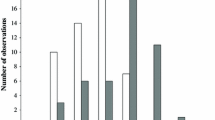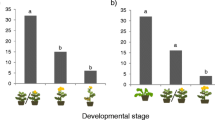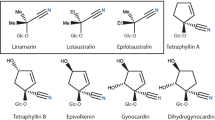Abstract
Cyanogenesis is a widespread chemical defence mechanism in plants against herbivory. However, some specialised herbivores overcome this protection by different behavioural or metabolic mechanisms. In the present study, we investigated the effect of presence or absence of cyanogenic glycosides in birdsfoot trefoil (Lotus corniculatus, Fabaceae) on oviposition behaviour, larval preference, larval development, adult weight and nectar preference of the common blue butterfly (Polyommatus icarus, Lycaenidae). For oviposition behaviour there was a female-specific reaction to cyanogenic glycoside content; i.e. some females preferred to oviposit on cyanogenic over acyanogenic plants, while other females behaved in the opposite way. Freshly hatched larvae did not discriminate between the two plant morphs. Since the two plant morphs differed not only in their content of cyanogenic glycoside, but also in N and water content, we expected these differences to affect larval growth. Contrary to our expectations, larvae feeding on cyanogenic plants showed a faster development and stronger weight gain than larvae feeding on acyanogenic plants. Furthermore, female genotype affected development time, larval and pupal weight of the common blue butterfly. However, most effects detected in the larval phase disappeared for adult weight, indicating compensatory feeding of larvae. Adult butterflies reared on the two cyanogenic glycoside plant morphs did not differ in their nectar preference. But a gender-specific effect was found, where females preferred amino acid-rich nectar while males did not discriminate between the two nectar mimics. The presented results indicate that larvae of the common blue butterfly can metabolise the surplus of N in cyanogenic plants for growth. Additionally, the female-specific behaviour to oviposit preferably on cyanogenic or acyanogenic plant morphs and the female-genotype-specific responses in life history traits indicate the genetic flexibility of this butterfly species and its potential for local adaptation.





Similar content being viewed by others
References
Ballhorn DJ, Lieberei R, Ganzhorn JU (2005) Plant cyanogenesis of Phaseolus lunatus and its relevance for herbivore-plant interaction: the importance of quantitative data. J Chem Ecol 31:1445–1473
Bazin A, Blaise S, Cartier D (1997) Polymorphism of two defence mechanisms in Lotus corniculatus L. (Fabaceae); relation with abiotic factors. Acta Bot Gallica 144:433–442
Beesley SG, Compton SG, Jones DA (1985) Rhodanese in insects. J Chem Ecol 11:45–50
Bergstrom A, Nylin S, Nygren GH (2004) Conservative resource utilization in the common blue butterfly—evidence for low costs of accepting absent host plants? Oikos 107:345–351
Bernays EA, Chapman RF (1994) Host-plant selection by phytophagous insects. Chapman & Hall, New York
Brattsten LB, Samuelian JH, Long KY, Kincaid SA, Evans CK (1983) Cyanide as a feeding stimulant for the southern army worm, Spodoptera eridania. Ecol Entomol 8:125–132
Briggs MA (1990) Relation of Spodoptera eridania choice to tannins and protein of Lotus corniculatus. J Chem Ecol 16:1557–1564
Burghardt F, Knüttel H, Becker M, Fiedler K (2000) Flavonoid wing pigments increase attractiveness of female common blue (Polyommatus icarus) butterflies to mate-searching males. Naturwissenschaften 87:304–307
Burghardt F, Proksch P, Fiedler K (2001) Flavonoid sequestration by the common blue butterfly Polyommatus icarus: quantitative intraspecific variation in relation to larval hostplant, sex and body size. Biochem Syst Ecol 29:875–889
Chapman RF (1990) Food selection. In: Chapman RF, Joern A (eds) Biology of grasshoppers. Wiley, New York, pp 39–72
Crawley MJ (1993) GLIM for ecologists. Blackwell, Oxford
Dowd PF (1988) Detoxification of plant substances by insects. In: Morgan ED, Mandava NB (eds) CRC handbook of natural pesticides. Insect attractions and repellents, vol IV. CRC, pp 181–225
Ebert G (1993) Die Schmetterlinge Baden-Württembergs. Band 2. Ulmer, Stuttgart
Engler HS, Spencer KC, Gilbert LE (2000) Preventing cyanide release from leaves. Nature 406:144–145
Feigl F, Anger V (1966) Replacement of benzidine by copper ethylacetoacetate and tetrabase as spoot-test for hydrogen cyanide and cyanogen. Analyst 91:282–284
Fiedler K, Hölldobler B (1992) Ants and Polyommatus icarus immatures (Lycaenidae)—sex-related development benefits and cost of ant attendance. Oecologia 91:468–473
Gleadow RM, Woodrow IE (2000) Temporal and spatial variation in cyanogenic glycosides in Eucalyptus cladocalyx. Tree Physiol 20:591–598
Goverde M, Bazin A, Shykoff JA, Erhardt A (1999) Influence of leaf chemistry of Lotus corniculatus (Fabaceae) on larval development of Polyommatus icarus (Lepidoptera, Lycaenidae): effects of elevated CO2 and plant genotype. Funct Ecol 13:801–810
Goverde M, van der Heijden MGA, Wiemken A, Sanders IR, Erhardt A (2000) Arbuscular mycorrhizal fungi influence life history traits of a lepidopteran herbivore. Oecologia 125:362–369
Goverde M, Granados J, Erhardt A (2001) Host-plant selection in three different moth larvae. Mitt Schweiz Ent Ges 74:143–150
Goverde M, Erhardt A, Stocklin J (2004) Genotype-specific response of a lycaenid herbivore to elevated carbon dioxide and phosphorus availability in calcareous grassland. Oecologia 139:383–391
Honda K, Nishii W, Hayashi N (1997) Oviposition stimulants for sulfur butterfly, Colias erate poliographys: cyanoglucosides as synergists involved in host preference. J Chem Ecol 23:323–331
Hruska AJ (1988) Cyanogenic glucosides as defense compunds: a review of the evidence. J Chem Ecol 14:2213–2217
Jones DA (1988) Cyanogenesis in animal-plant interactions. In: Evered D, Harnett S (eds) Cyanide compounds in biology. Wiley, Chichester, pp 151–165
Jones DA (1998) Why are so many food plants cyanogenic? Phytochemistry 47:155–162
Knüttel H, Fiedler K (2001) Host-plant-derived variation in ultraviolet wing patterns influences mate selection by male butterflies. J Exp Biol 204:2447–2459
Mattson WJ (1980) Herbivory in relation to plant nitrogen content. Annu Rev Ecol Syst 11:119–161
McArthur C, Hagerman AE, Robbins CT (1986) Physiological strategies of mammalian herbivores against plant defenses. In: Miller JR, Miller TA (eds) Insect–plant interactions. Springer, New York, pp 103–114
Mevi-Schütz J, Erhardt A (2005) Amino acids in nectar enhance butterfly fecundity: a long-awaited link. Am Nat 165:411–419
Mevi-Schütz J, Goverde M, Erhardt A (2003) Effects of fertilization and elevated CO2 on larval food and butterfly nectar amino acid preference in Coenonympha pamphilus L. Behav Ecol Soc 54:36–43
Nahrstedt A (1988) Cyanogenesies and the role of cyanogenic compounds in insects. In: Evered D, Harnett S (eds) Cyanide compounds in biology. Wiley, Chichester, pp 131–144
Parsons J, Rothschild M (1964) Rhodanese in the larva and pupa of the common blue butterfly (Polyommatus icarus Rott.) (Lepidoptera). Entomol Gaz 15:58–59
Riis L, Bellotti AC, Bonierbale M, O’Brien GM (2003) Cyanogenic potential in cassava and its influence on a generalist insect herbivore Cyrtomenus bergi (Hemiptera: Cydnidae). J Econ Entomol 96:1905–1914
Rosenthal GA, Berenbaum MR (1991) Herbivores. Their interactions with secondary plant metabolites. Academic Press, San Diego
SAS (1995) JMP user’s guide, version 3.1. SAS, Cary
Schappert PJ, Shore JS (1999) Effects of cyanogenesis polymorphism in Turnera ulmifolia on Euptoieta hegesia and potential Anolis predators. J Chem Ecol 25:1455–1479
Scheirs J, De Bruyn L, Verhagen R (2002) Seasonal changes in leaf nutritional quality influence grass miner performance. Ecol Entomol 27:84–93
Schurian KG (1988) Revision der Lysandra-Gruppe des genus Polyommatus Latr. (Lepidoptera: Lycaenidae). University Frankfurt am Main, Frankfurt
Scriber JM (1978) Cyanogenic glycosides in Lotus corniculatus. Their effect upon growth, energy budget, and nitrogen utilization of the southern armyworm, Spodoptera eridania. Oecologia 34:143–155
Seigler DS (1991) Cyanide and cyanogenic glycosides. In: Rosenthal GA, Berenbaum MR (eds) Herbivores. Their interaction with secondary plant metabolites. Academic Press, San Diego, pp 35–78
Slansky F (1993) Nutritional ecology: the fundamental quest of nutrients. In: Stamp NE, Casey TM (eds) Caterpillars: ecological and evolutionary constraints on foraging. Chapman & Hall, New York, pp 29–91
Welham SJ, Thompson R (2006) REML analysis of mixed models. In: Payne RW, Harding SA, Murray DA, Soutar DM, Baird DB, Welham SJ, Kane AF, Gilmour AR, Thompson R, Webster R, Tunnicliffe Wilson G (eds) The Guide to GenStat Release 9. VSN International, Hemel Hempstead, UK, pp 607–704
Zagrobelny M, Bak S, Rasmussen AV, Jorgensen B, Naumann CM, Moller BL (2004) Cyanogenic glucosides and plant–insect interactions. Phytochemistry 65:293–306
Zagrobelny M, Bak S, Ekstrom CT, Olsen CE, Moller BL (2007) The cyanogenic glucoside composition of Zygaena filipendulae (Lepidoptera: Zygaenidae) as effected by feeding on wild-type and transgenic lotus populations with variable cyanogenic glucoside profiles. Insect Biochem Mol Biol 37:10–18
Acknowledgements
We are especially grateful to Kathrin Schweizer, Daniel Bretscher and Olivier Bignucolo for technical support and two anonymous referees for critical comments on the manuscript. This research was supported by grants from the Swiss Priority Program Environment of the Swiss National Science Foundation to A. Erhardt (No. 5001-044622/1). All experiments conducted in this study comply with French and Swiss federal laws.
Author information
Authors and Affiliations
Corresponding author
Additional information
Communicated by Konrad Fiedler.
Rights and permissions
About this article
Cite this article
Goverde, M., Bazin, A., Kéry, M. et al. Positive effects of cyanogenic glycosides in food plants on larval development of the common blue butterfly. Oecologia 157, 409–418 (2008). https://doi.org/10.1007/s00442-008-1096-9
Received:
Accepted:
Published:
Issue Date:
DOI: https://doi.org/10.1007/s00442-008-1096-9




